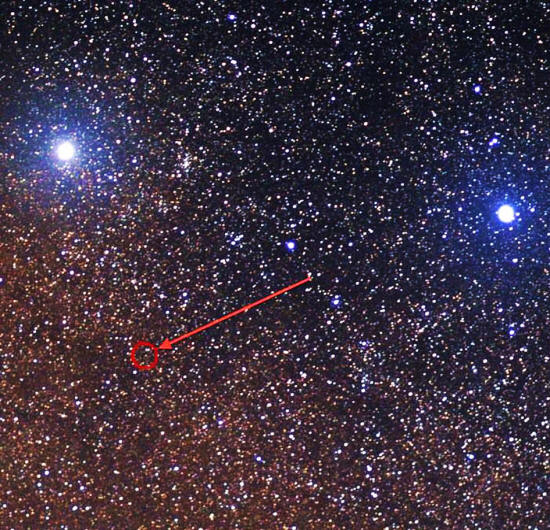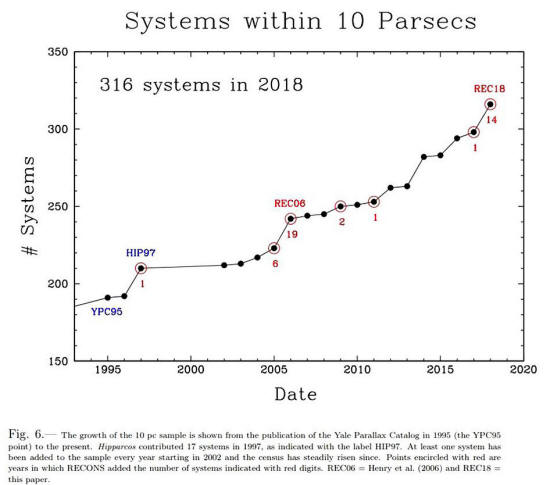1.) There are 316
discovered star systems within 10 parsecs.
This is an incredible
improvement over what we knew back at the start of RECONS; the
number of known
star systems within 10 parsecs was only 191;
that number is now up to 316 today.
The 125 new star
systems that have been added by RECONS and other teams searching
for nearby stars represents a 65% increase over the original
figure.
Additionally, we now
have accurately measured
parallaxes for all of them.
These are all
intrinsically faint systems, where of the 125:
Many star systems
have multiple members; "dominated by" means which class of star
is the brightest, most luminous star in the system.
With this latest data
release, coverage has been so good, thorough, and deep, that the
RECONS collaboration has announced that we have now,
confidently, found more than 90% of all star systems within 10
parsecs.
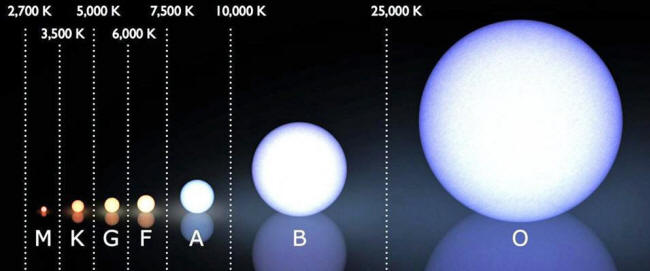
The
(modern) Morgan–Keenan spectral classification system,
with the temperature range of each star class
shown above it, in kelvin.
The
overwhelming majority of stars today are M-class stars,
with only 1 known O- or B-class star within 25 parsecs.
Our
Sun is a G-class star.
(Wikimedia Commons user LucasVB, additions by E. Siegel)
2.) Bright
stars are exceedingly rare; the faintest stars are by far the
most common
Stars, as we classify
them, come in seven different types:
O, B, A, F, G, K,
and M, arranged from bluest-and-hottest to
reddest-and-coolest.
These represent stars
that are burning hydrogen into helium (or heavier elements)
through nuclear fusion in their cores.
Brown
dwarfs are
failed stars that aren't quite massive enough to become M-class
stars, while
white dwarfs are the leftover cores of Sun-like
stars that have already ended their lives by burning through all
of their nuclear fuel.
Of these 316 systems:
-
0 of them are
dominated by O-class stars (0%)
-
0 of them by
B-class stars (0%)
-
4 of them by
A-class stars (1.3%)
-
8 of them by
F-class stars (2.5%)
-
19, including
the Sun, by G-class stars (6.0%)
-
29 by K-class
stars (9.2%)
-
222 by
M-class stars (66.5%)
-
37 by brown
dwarfs (11.7%)
-
9 by white
dwarfs (2.8%)
This tells us that,
of the nearby star systems made up of true stars (O, B, A, F, G,
K, and M), a whopping 82% of them are M-class stars:
the red
dwarfs.
Our Sun is quite
uncommon in the grand scheme of things.
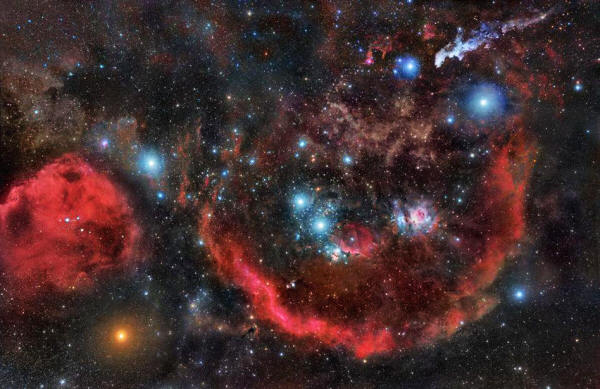
The constellation of Orion,
along with the great molecular cloud complex
and including its brightest stars.
As impressive as these stars are,
they're all much farther than 10 parsecs away;
appearing bright because they're intrinsically bright.
Only 51 stars within 10 parsecs
are visible to the naked eye.
(Rogelio Bernal Andreo)
3.) The
nearest O- or B-class star is a whopping 79 light years away
That would be
Regulus,
at the very faint end of the
B-class of stars.
Regulus is the
brightest star in the constellation of Leo, and is overall the
21st brightest star in the sky. The reason O-class and B-class
stars are so rare is that they're both massive and short-lived.
Once you get far away
from a star-forming region, which the Sun is (being between
spiral arms at the moment), it's only going to be relatively
older stars that are in your neighborhood.
Regulus, at the
low-end of the B-class, has lived for around 1 billion years and
doesn't have much more time left before moving onto the next
phase of its life cycle, but as part of a quadruple star system,
it's still hanging in there.
But you have to go
way past 10 parsecs, out to nearly 25, to find it.
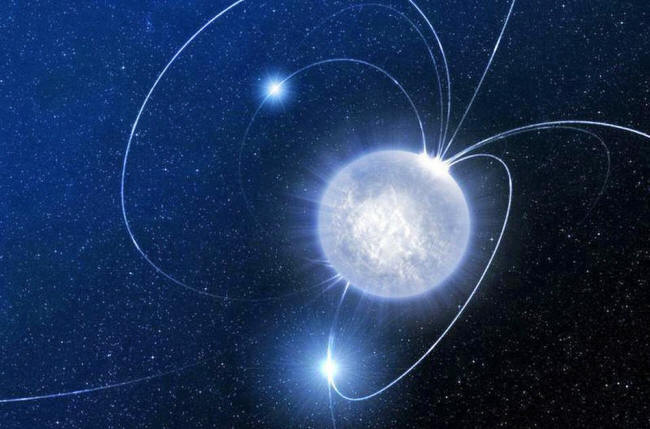
A
neutron star
is
one of the densest collections
of
matter in the Universe,
but
there is an upper limit to their mass.
Exceed it, and the neutron star
will further collapse to form a black hole.
(ESO/Luís
Calçada)
4.) There
are no neutron stars or black holes within 10 parsecs.
And, to be honest,
you have to go out way further than 10 parsecs to find either of
these!
In 2007,
scientists discovered the X-ray object 1RXS J141256.0+792204,
nicknamed "Calvera," and
identified it as a neutron star. This object is a
magnificent 617 light years away, making it the closest neutron
star known.
To arrive at
the closest known black hole, you have to go all the way out to
V616 Monocerotis, which is over 3,000 light years away.
Of all the 316
star systems identified within 10 parsecs, we can definitively
state that there are none of them with black hole or neutron
star companions.
At least where
we are in the galaxy, these objects are rare.
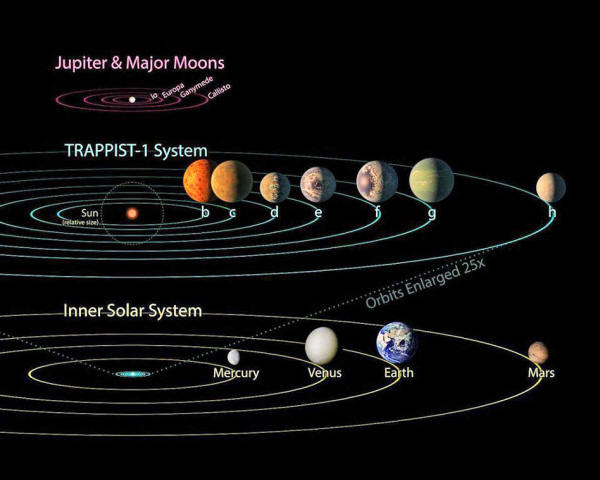
TRAPPIST-1 system
compared to the solar system;
all seven planets
of TRAPPIST-1 could fit inside the orbit of Mercury.
By delivering the
mass, radius, atmospheric content
and orbital
parameters of the planets,
along with
astronomical information about our star,
someone with
advanced technology could
identify our
Solar System from afar.
(NASA /
JPL-Caltech)
5.) There are currently 56 known
exoplanets within 10 parsecs
Despite the
fact that there are over 400 known stars within 10 parsecs, only
26 have been confirmed to have planetary systems.
The old
record-holder was
HD 219134, with six confirmed planets and one additional
candidate, while the closest is
Proxima Centauri b, at a
distance of merely 4.2 light years.
TRAPPIST-1 just
misses out; at 40 light years distant, it's a shade over 12
parsecs away.
One of the
primary missions of
TESS, which successfully launched last week, will be to
search for transiting planets around these stars.
If it finds,
identifies, and characterizes them, then future telescopes like
James Webb and the 30-meter-class telescopes currently being
built on Earth will have a chance to observe them.
For the first
time, if nature is kind, humanity will be searching for
atmospheric signs of life on potentially inhabited worlds around
other stars.
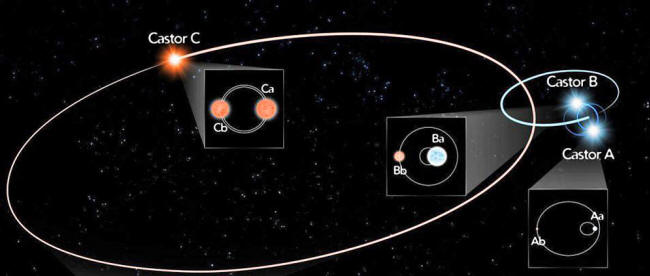
While practically
all the stars in the night sky
appear to be
single points of light, many of them
are multi-star
systems, with approximately
50% of the stars
we've seen bound up in multi-star systems.
Castor is the
system with the most stars within 25 parsecs:
it is a sextuple
system.
(NASA /
JPL-Caltech / Caetano Julio)
6.) But multiple star systems are
very common
We could see
this within 10 parsecs easily, where stars like the Sun may be
singles, but binaries, trinaries, and more are quite common.
The nearest
star system to ours,
Alpha Centauri, is a triple system, and there are even two
quintuple systems,
GJ0644 and
Alpha Librae, within 10 parsecs.
There are well
over 100 additional stars that are part of the 316 known systems
when you account for the multiple-star nature of what's out
there.
But scientists
wanted to do better, and so RECONS decided to extend its search
over the past decade out to 25 parsecs.
In doing so, as
of 2014, it had found:
-
1533
single star systems,
-
509
binary systems,
-
102
triple systems,
-
19
quadruple systems,
-
4
quintuple systems, and even
-
1
sextuple system.
That sextuple
system,
Castor, has been known since ancient times and is the 24th
brightest star system in the night sky, at a distance of merely
51 light years away.
It is more than
10 parsecs away, but, at 15.7, only barely.
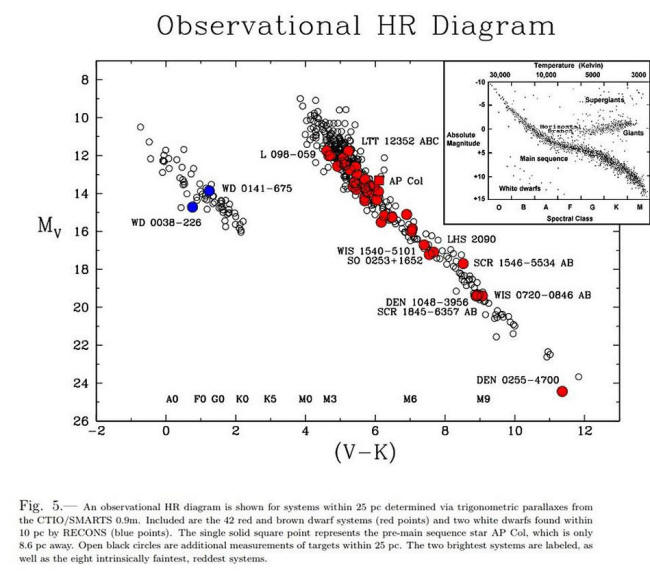
The standard HR
diagram,
of color vs.
magnitude, is shown inset.
As found by the
latest studies, additional dwarf stars
help fill in only
the lowest-magnitude end of
what's within 10
parsecs of us.
(T. J. Henry et
al. (2018), main, with NASA / CXC, inset.)


